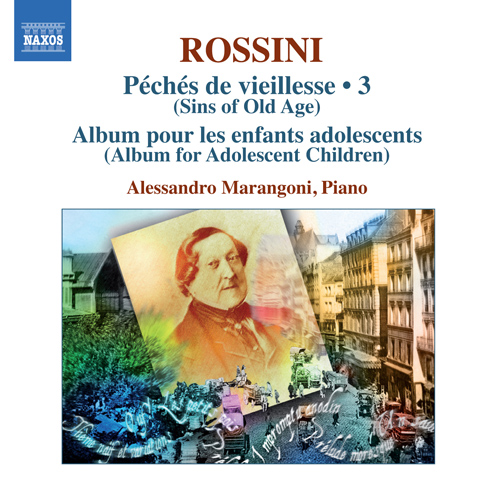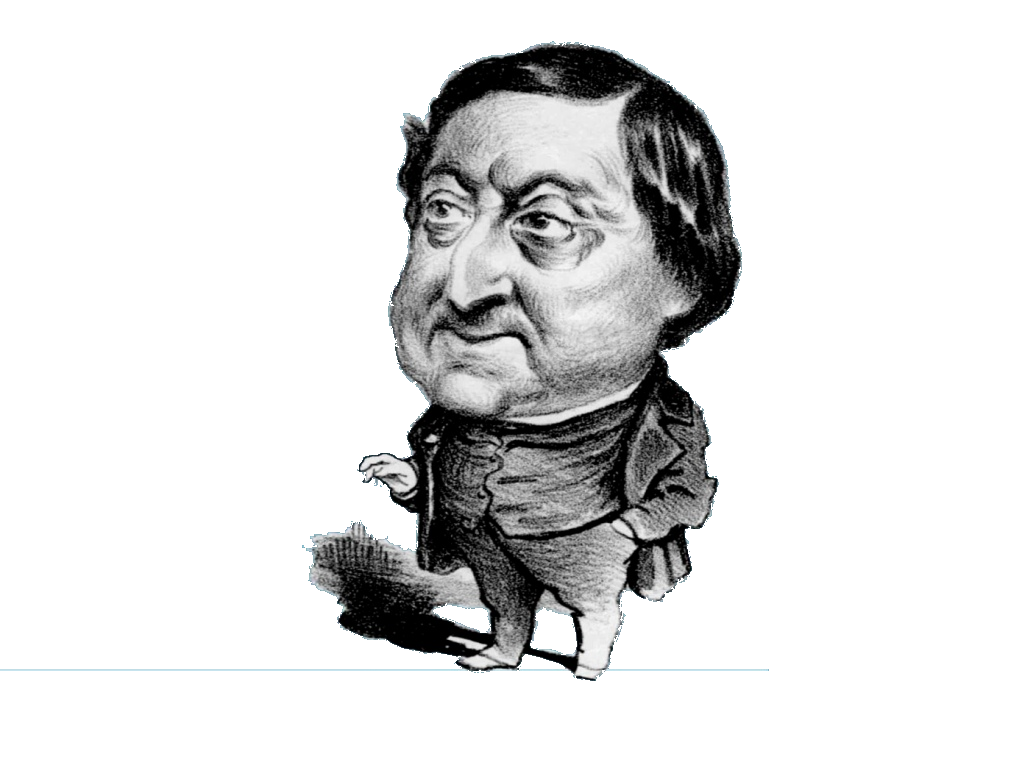 |
|
1 CD -
8.572315 - (p) & (c) 2009
|
|
| PÉCHÉS
DE VIEILLESSE - Volume 3 |
|
|
|
|
|
|
|
| Gioachino ROSSINI
(1791-1868) |
Péchés
de vieillesse - Volume V "Album pour
les enfants adolescents"
|
|
|
|
|
-
No. 1 - Premiere communion
|
|
5' 12" |
1 |
|
-
No. 2 - Thème naïf et variations,
idem... |
|
5' 22" |
2 |
|
-
No. 3 - Saltarello à l'Italienne
|
|
4' 48" |
3 |
|
- No. 4 - Prélude
moresque |
|
4' 52" |
4 |
|
- No. 5 - Valse lugubre
|
|
4' 02" |
5 |
|
- No. 6 - Impromptu
anodin
|
|
5' 16" |
6 |
|
- No. 7 - L'innocence
Italienne - La candeur française |
|
7' 49" |
7 |
|
- No. 8 - Prélude
convulsif
|
|
5' 44" |
8 |
|
- No. 9 - La lagune de
Venise à l'expiration de l'année 1861!!! |
|
6' 50" |
9 |
|
- No. 10 - Ouf! Les
petits pois |
|
5' 15" |
10 |
|
- No. 11 - Un sauté
|
|
5' 08" |
11 |
|
- No. 12 - Hachis
romantique |
|
5' 09" |
12 |
|
|
|
|
|
Alessandro MARANGONI, pianoforte
Stenway & Sons (Angelo Fabbrini
collection)
|
|
|
|
|
|
Luogo
e data di registrazione |
|
Auditorium
di Mortara, Pavia (Italia) - 30 giugno
/ 1 luglio 2008 |
|
|
Registrazione:
live / studio
|
|
studio |
|
|
Producer |
|
Edoardo
Lambertenghi |
|
|
Recording
engineer |
|
Edoardo
Lambertenghi
|
|
|
Editor |
|
Edoardo Lambertenghi
|
|
|
Assistant
producer
|
|
Paolo
Zeccara
|
|
|
Cover |
|
Paolo
Zeccara |
|
|
Edizione
CD |
|
NAXOS |
8.572315 | (1 CD) | durata 65' 28" |
(p) & (c) 2009 | DDD |
|
|
Note |
|
-
|
|
|
|
|
Gioachino
Antonio Rossini, one of the most
successful and popular operatic
composers of his time, was born
in Pesaro in 1792, five months
after the marriage of his
parents. His father, a
brass-player and later teacher
of the French horn at the
Bologna Accademia, had a modest
career, disturbed by the
political changes of the period
as the French replaced the
Austrians in Northern Italy.
Rossini’s mother was a singer
and as a boy Rossini made his
appearance with his father in
the pit orchestra and from time
to time as a singer with his
mother on stage, going on to
work as a keyboard-player in the
opera orchestra.
Rossini’s early studies in music
were with his father and mother,
and with other teachers through
the generosity of rich patrons.
In childhood he had already
started to show ability as a
composer and his experience in
the opera-house bore natural
fruit in a remarkable and
meteoric career that began in
1810 with the production of La
cambiale di matrimonio in
Venice.
There followed a series of
operas, comic and tragic, until
the relatively poor reception of
Semiramide in Venice in 1823
turned Rossini’s attention to
Paris. Under the Bourbon King
Charles X Rossini staged French
versions of earlier works and in
1829 Guillaume Tell. A
contract for further operas came
to nothing when the King was
replaced in the revolution of
1830 by Louis-Philippe, although
eventually, after some six
years, Rossini was able to have
his agreed annuity restored.
With matters settled in France,
in 1836 he returned to Italy and
in spite of ill health concerned
himself with the affairs of the
Liceo Musicale in Bologna. The
revolutionary disturbances there
in 1848, activities with which
he had little sympathy, seemed
to threaten him and his second
wife, Olympe Pélissier, whom he
had married in 1846, after the
death of his first wife, the
singer Isabella Colbran, from
whom he had been legally
separated since 1837. For his
own safety he moved first to
Florence, but in 1855, partly in
a search for better health,
returned to Paris. In that city
and a few years later at his new
villa at Passy he passed the
rest of his life.
Rossini’s last ten years brought
a return to composition,
principally with a series of
pieces described as Péchés
de vieillesse (Sins of Old
Age). Some of these are based on
earlier works, some designed for
performance at the informal
Saturday evenings when he
entertained guests in Paris, and
others simply musical obiter
dicta, as it were, pieces
written as the mood took him.
The Péchés de vieillesse
are included in thirteen
volumes, with the fourth to the
eighth grouped together by
Rossini as ‘Un peu de tout.
Recueil de 56 morceaux
semi-comiques pour le piano
(“Je dédie ces Péchés de
vieillesse aux pianistes de la
4.me classe à la quelle j’ai
l’honneur d’appartenir”)
(A little of everything.
Collection of 56 semi-comic
pieces for the piano: “I
dedicate these Sins of Old Age
to pianists of the fourth class,
to which I have the honour to
belong”). Rossini was unfairly
modest about his abilities as a
pianist, which were, it seems,
not inconsiderable. Other
volumes also contain piano
pieces.
The fifth volume of the Péchés
de vieillesse has the
title Album pour les enfants
adolescents (Album for
Adolescent Children). It
contains twelve pieces, starting
with Première Communion,
its opening a pious Andantino
religioso, leading to Récréation,
marked Vivace, a varied waltz
sequence, the secular
celebration of the event. The
second piece has the title Thème
naïf et variations, idem .
The G major theme, Andantino
mosso, has an easy lilt
and is followed by a first
variation with triplet
figuration. The second variation
starts with a rapid ascending
scale in a pattern of shorter
notes and is followed by an E
minor version of the original
theme. The last variation brings
rapid octaves in both hands,
before the original theme
returns, its closing marked by a
brief suggestion of a cadenza.
The third piece, Saltarello
à l’italienne, is
characterized by its dotted
rhythms, maintained throughout
in a dance with two contrasting
trio sections and a dramatic
ending. The Prélude moresque
brings conventional touches of
the exotic and the Valse
lugubre has brief
suggestions of the lugubrious
with hints of minor keys in a
predominantly major context. The
Impromptu anodin that
follows again seems to bear a
title derived from the principle
lucus a non lucendo, in
that there is nothing anodyne
about it.
L’innocence italienne: la
candeur française
contrasts the gentler textures
of Italian innocence with the
brillliant and mercurial French
candour, the latter displayed
with some virtuosity and a
glimpse of Offenbach. The eighth
piece, Prélude convulsif,
is characterized by its dynamic
contrasts and syncopated
rhythms, twice interrupted by
passages of elegant baroque
counterpoint. La Lagune de
Venise à l’expiration de
l’année 1861!!! (The
Venice Lagoon at the End of the
Year 1861!!!) has the lilt of a
barcarolle. The year 1861
brought Italian unity under King
Vittorio Emanuele II, but Venice
had been taken again under
Austrian rule in 1848 by Marshal
Radetsky, who remained governor
of Lombardo-Veneto for a number
of years. Venice only became
part of the united Italy in
1866. Radetsky makes his
appearance in this piece with
emphatic chords for L’ombra
di Radetski!!!, and the
music is again interrupted by
chords marking the arrival of S.
M.!!!, presumably a
reference to the Emperor Franz
Joseph, whose wife had taken up
residence in Venice in October
1861, taking refuge from the
pressures of court life in
Vienna and visited in Venice by
her anxious husband on various
occasions. The arrival is
followed by La lagune
baissant d’une tierce (The
Lagoon descending a third).
Ouf! Les petits pois (Ah!
The peas) has more than a hint
of Mendelssohn and of earlier
composers, its title a
light-hearted hint at Rossini’s
gastronomic interests. It is
followed by Un sauté, a
lilting Chopinesque waltz with a
contrasting trio section. The
gastronomic connotations
continue with the final Hachis
romantique (Romantic
Hash), which, after a brief
introduction, proceeds to
something more akin to Clementi
in perpetual motion before final
arpeggiated chords and a
concluding and definitive tremolo.
Keith Anderson
|
|

